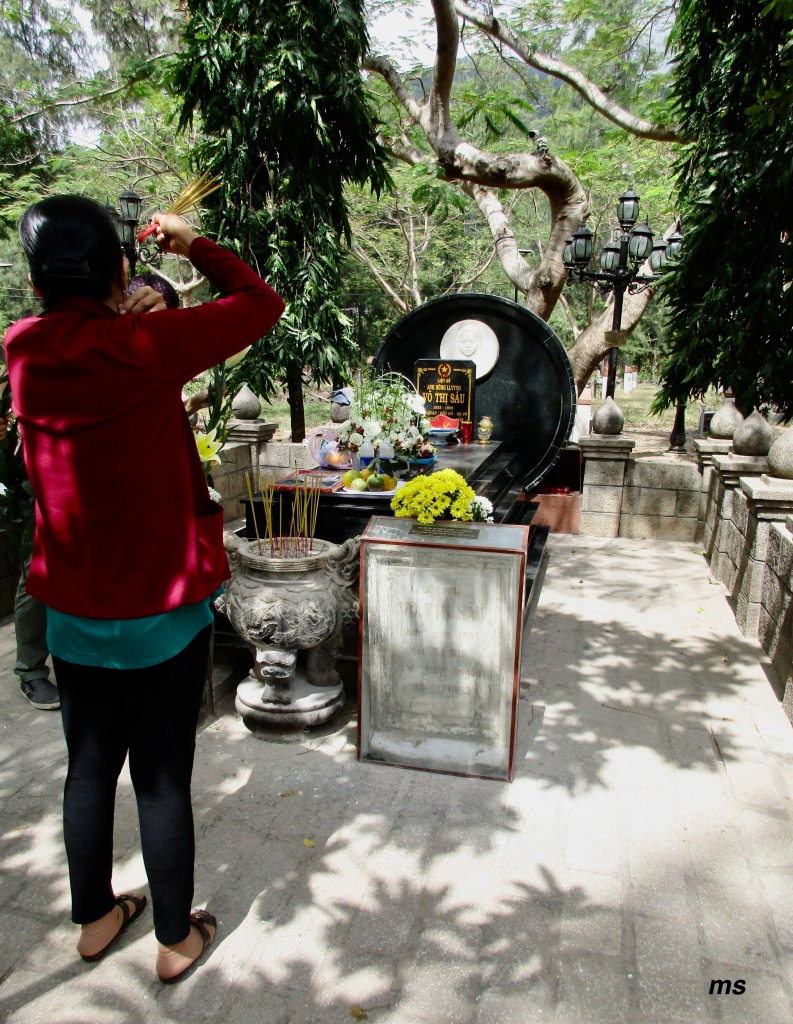I took a flight to Con Son not wishing to suffer from seasickness on a ferry. The island had instant appeal. Tree lined streets shaded French style bungalows where only the occasional sound of traffic was heard. The quiet town reminded me a little of Bali before its tourist invasion—peaceful with few tourists, but unlike the Indonesian island from that time, Con Dao had a dark past.

When WW11 broke out, the Japanese invaded Vietnam. After the Japanese surrender, negotiations with the French (who’d brought their guillotines to Vietnam) foiled. The Vietnamese fought until 100,000 French soldiers had died and peace talks began in Geneva in 1954. But the country remained divided, and the U.S. had not signed the peace accord. With U.S. puppets in the south, the northern Viet Cong infiltrated the south to rid the country of the U.S. This set off the continual bombing by the U.S. on “targets”. By 1968, with coverage of what was happening in Vietnam, the U.S. public began antiwar protests. In 1969, when some 500 village massacres became known, more pressure was placed on the U.S. government to end the war, but still they faltered despite more than two million Vietnamese having died. It wasn’t until North Vietnamese soldiers captured the U.S. military operations Saigon headquarters that the U.S. withdrew in 1973.

Back several streets on that first afternoon, I discovered this relaxing haven had been used as a prison for those who opposed French colonial rule, followed by the U.S. puppet Vietnamese government against their own dissidents, and lastly by the U.S.
Moss stained walls surrounded Phu Hai Prison while the smell of urine hung near the barred windows. I didn’t venture inside. It was dismal enough from the exterior. Next, I wandered to the prison where the notorious tiger cages were located but it was just as depressing. I learned more about those infamous cells at Con Son Museum.

Located on the edge of Con Son, a ten-minute walk away, the museum was mostly about the incarceration and torture of the Vietnamese at the hands of the French colonial rulers followed by the U.S.A.’s puppet regime during the U.S. War on Vietnam. I’d read a novel about a prisoner in a tiger cage, but it wasn’t set in Vietnam. Still, the story hadn’t seemed any different from what I was learning as I gingerly went from one display to the next.

Prisoners in the tiger cages were beaten daily, often until they lost consciousness. Under the French some 2,000 political/revolutionary prisoners were house in 120 cages and jabbed with spiked sticks like caged animals. Vo Thi Sau, a famous female revolutionary, was executed in this prison.

During the U.S. War on Vietnam, Tom Harkin knew of their existence from an ex-prisoner who drew a map so Harkin could locate them. Even though the official leading the inspection had tried to hide that section of the prison, a guard came through the cages’ entrance door and Harkin barged through. He took photos and refused to hand them over, thus exposing the horrors of this section of the prison that incarcerated both U.S. and Vietnamese prisoners.

Within walking distance outside of Con Son was Hang Duong Cemetery—another reminder of what the Vietnamese had suffered. On my hike to the cemetery, I passed cows grazing by the side of the road, papaya trees and even a field of corn. Before I reached the graveyard entrance, I entered a pristine temple. Behind the temple, hills rose to misty peaks. Lush vegetation surrounded the buildings where sweepers and gardeners kept the site immaculate. A large gong was housed in one building. Carved dark wood trimmed buildings and I was the only sightseer during my early morning visit. What a peaceful setting.

Past the tree-lined entrance into Hang Doung Cemetery, a heaviness pressed down on me. The site was lovingly maintained, and the silence broken only by chirping birds, a rooster’s crow, an occasional dog barking or the wind through the trees. I was surrounded by grave upon grave, most of them unnamed. Every grave however, had incense sticks and flowers reminding me that all their suffering was not forgotten.
At the cemetery, a circular structure stood in the heart of the grounds. Within a round enclosure was a frieze along the back wall that told of the suffering prisoners endured. From the scenes it was clear many died from starvation though many were executed too. In the centre of the remembrance hall, was an obelisk.

Following the meandering paths, I came upon Vo Thi Sau’s grave. The teenage resistance fighter’s huge grave was covered with flowers and fruits. While I stood by, a woman prayed before her tomb while two others added to the already substantial array of flowers. I learned later, there was another shrine dedicated to her opposite the museum in Con Son.
I left the graveyard with a dismal feeling, but with a greater understanding of colonialism’s destruction.


I haven’t heard of Con Son Island. What a dark horrendous history. Interesting observations between the peaceful surroundings you found today and the area’s past events.
LikeLiked by 1 person